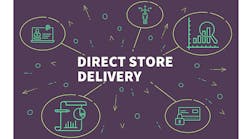How DSD Technology Can Improve Efficiency During the Labor Shortage
You’d be hard-pressed to find an industry that wasn’t hit by the Great Resignation. From retail and food and beverage to healthcare and transportation, employers everywhere are struggling to fill the 11 million positions that remain unfilled. And yet the total number of people who are employed has declined by 5 million since the pandemic began.
With manufacturing among the sectors that have struggled to overcome these hiring hurdles, they need any advantage they can get—in any capacity—to offset the overwhelming resources required for manual processes. One area in which technology can make a difference is in direct store delivery (DSD), which gives manufacturers a way to provide products directly to retailers, restaurants and other businesses at the point of purchase.
Once bogged down by manual invoicing, manual inventory transactions, and manual adjustments for credits and returns, DSD is a valuable but often inefficient form of sales. But with the right technology, the most time-consuming tasks can be simplified and automated, improving DSD efficiency while allowing drivers to focus on higher-value objectives.
Labor-Intensive Tasks Demand a Technological Advantage
While the Great Resignation has been hard for all, manufacturing companies have been particularly challenged by the current climate. According to the National Association of Manufacturers, the sector is operating with 219,000 fewer workers than before the pandemic. This is in spite of the fact that businesses added 349,000 manufacturing workers in 2021, the highest number of hires since 1994.
This gap could grow exponentially over the next eight years, with Deloitte estimating that U.S. manufacturers will have 2.1 million unfilled jobs by 2030. Deloitte also found that 36% of U.S. manufacturing executives believe it is now harder to find the right talent than it was just four years ago in 2018.
Manufacturers cannot hire enough staff to fill their open positions. Instead of trying to complete every task with manpower that doesn’t exist, manufacturers can use technology to save time and allow staff to focus on the most important aspects of their job. For example, there is a lot of additional labor involved in managing the DSD delivery process. With the right technology, manufacturers can manage approvals (proof of delivery), inventory (in real-time), credits and returns (eliminating the need for manual adjustments), and automate reconciliation for both inventory depletion and revenue posting.
Commissions, Errors and Theft Are No Longer a Concern
Technology is also empowering manufacturers to increase sales and generate revenue faster with the option to offer a presale to retailers, restaurants and other customers. This provides manufacturers with a monetary advantage even before the products are delivered. If a customer would prefer to buy directly off the truck upon arrival, that’s still possible. All items can then be tracked later on to determine the lots that were sold to each customer using a simple 2D barcode.
This same technology offers the added benefit of allowing manufacturers to better report and calculate commissions for drivers, who effectively serve as salespeople and may receive pay based on performance. For example, the number of units sold and the number of stops may be a factor in determining how much the driver receives. But without the right technology, manufacturers would struggle to ensure their payouts were accurate every time. This type of technology also gives manufacturers more options in offering commission incentives for new hires without adding manpower to track the data.
Theft is another concern for companies that manage their inventory with manual entries. While most drivers are honest, hard-working individuals, there are those who may be tempted to take advantage of a situation or may simply make a mistake. Thus, if they have to write down an adjustment after someone has signed an invoice, the opportunity for problems—intentional or inadvertent—is certainly there. Technology can digitize this process and allow credits to be added before a customer signs off on the proof of delivery (and prevent changes thereafter), removing the issues of a paper-based method.
DSD Can Live Up to Expectations with the Right Technology
Direct store delivery is an important way for manufacturers to sell and distribute goods to retailers, restaurants, breweries and other customers, but technology is needed to ensure that DSD lives up to expectations. DSD technology is especially important at a time when labor is short, and customers are growing impatient with the lack of product on their shelves. For drivers who are working on commission, technology empowers manufacturers to make sure they’re paying an accurate amount every time. And in dealing with concerns about theft or errors, technology can prevent issues before they become a problem.
Amanda Goodman is lead product consultant for ECI Software Solutions, a provider of cloud-based business management solutions.



